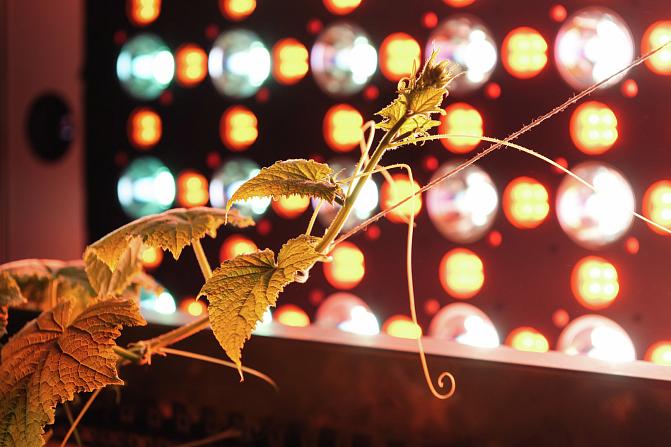
Piikkiö research infrastructure
On this page
The Piikkiö research infrastructure focuses on horticultural research. It is home to Finland's most important horticultural research platforms. Research is conducted in a variety of ways in open fields, growth tunnels, and greenhouses.


In Piikkiö, plant genetic resources are maintained in their natural growing environments, new berry and fruit varieties are bred and developed for Finnish conditions, and research is conducted on various open-field vegetables, fruits, and berries. In greenhouses, research is conducted on topics such as the energy and resource efficiency of greenhouses, vertical farming, and the cultivation of various production and ornamental plants.
Research greenhouses
The research greenhouses consist of three separate greenhouses with a total growing area of approximately 1,600 m2. The greenhouses can be used to conduct various types of research related to the cultivation of production plants.
- A total of 16 compartments.
- Various cultivation levels, tables, and troughs.
- Itumic greenhouse climate control system, shade curtains and misting equipment, carbon dioxide fertilization, energy measurement system, fertilizer mixers.
- Lighting with high-pressure sodium or LED lamps.
- A pre-treatment laboratory with versatile equipment and temperature-controlled storage and climate chambers are available.
- Use of camera technology: hyperspectral cameras, plant imaging and sensing unit.
VIS - Vertical farming unit
The VIS unit is a closed-loop vertical farming unit (26 m2) with automated and adjustable climate control. The unit can be used to develop or pilot various vertical farming solutions and systems for different plant species. In the VIS unit, plants are grown on stacked shelves.
The unit has been used, for example, for vertical farming of tall plants and offers the opportunity to study farming in conditions where arable land or water resources are limited.
- A closed-loop vertical farming unit completely isolated from the outside world.
- Cultivation area: 26 m2.
- Automated and adjustable climate control.
- Closed recirculating aquaculture (2 different cycles).
- Temperature, humidity, and other environmental controls: Itumic MultiStation 100.
- Spectrum-adjustable LED lights (36 units).
- Carbon dioxide concentration measurement.
- Irrigation pump control with timers (4 units).
- Novarbo mist curtain cooling.


Mobile plant phenotyping platform
The plant phenotyping platform is mobile and adapts to imaging plants of different sizes and growth habits. It provides tools for different types of chlorophyll fluorometry, thermal imaging, and RGB imaging. Diagnostics based on chlorophyll fluorescence can be used to measure plant activity during growth.
The mobile plant phenotyping platform enables imaging of plants from above and, uniquely, from the side. It can be used to analyze many physiological characteristics of plants. It facilitates high-throughput phenotyping experiments, in which multiple plants, seedlings, leaves, or leaf discs are imaged at once, opening up new possibilities for genetic screening and breeding.
The mobile plant phenotyping platform has been customized by Photon Systems Instruments (PSI), the world's leading manufacturer of plant research equipment.
Research fields of open field production
The open research fields can be used to conduct various experiments related to the cultivation of berries, fruits, vegetables, and landscaping plants. A separate fenced container test area enables the cultivation, care, and maintenance of seedlings. In the growing tunnels, it is possible to grow crops on the ground, in troughs, or on tables.
- Research fields: 25 hectares of fenced field area, sandy and clay soils, covered by an automated irrigation network.
- Container test areas: fenced container test area with automatic sprinkler and drip irrigation systems for experiments and for growing and maintaining seedlings.
- Growth tunnels: Total growing space approx. 1,000 m2. Cultivation possible on the ground, in troughs or on tables. Automatic irrigation and fertilization via a field irrigation system.
- Horticultural cultivation equipment: tractors, tillage equipment, sowing and planting equipment, irrigation equipment, plant protection sprayers, harvesting machines, and special horticultural equipment.
- A pre-processing laboratory with a wide range of equipment is available, as well as temperature-controlled storage and climate-controlled rooms.


Long-term conservation collections of horticultural plant genetic resources
- protection and conservation of horticultural genetic resources


Arboretum of woody plants
- The arboretum contains more than 200 species, varieties or forms of woody plants, planted in small stands.
- A special feature is the rhododendrons cultivated in Finland.
- National collection of plant genetic resources for species conserved in the forest environment.
Areas of research
- greenhouse research
- fruit and berry research
- field-scale vegetable research
- landscaping research
- forestry research
- hops research
RI services of Piikkiö




Contact
Allow marketing cookies to show the embedded content.
